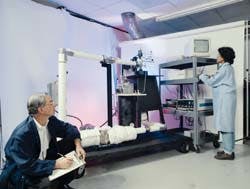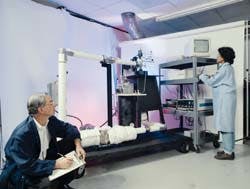Tests show best corrosion inhibitors for high pressure, temperature pipeline
Gale B. Farquhar
Texaco Inc.
Bellaire, Tex.Richard D. Kane, Dharma Abayarathna
CLI International Inc.
HoustonDavid H. Sanders
Texaco North Sea U. K. Co.
London
MAPS evaluates the corrosivity of field conditions involving flowing multiphase (oil-gas-water) environments. Using pipe flow and jet-impingement techniques, it also simulates the shear stress in pipeline systems produced by flowing fluids. The autoclave has also investigated both high and low temperatures and acid-gas partial pressures and the performance of corrosion inhibitors (Fig. 2).Autoclave tests have determined corrosion-inhibitor effectiveness under the severe flow conditions anticipated for a pipeline to serve Texaco North Sea U.K. Co.'s Erskine field, the North Sea's first high pressure, high-temperature field.
Production will begin later this year (OGJ, Mar. 10, 1997, p. 27).
The tests evaluated the inhibitors' performances over extended time and under varying conditions of flow-induced wall shear stress and closely simulated Erskine pipeline environment.
The performances of these two inhibitors were determined on both conventional X-65 and a new 0.5% Cr-enhanced X-65 steel at inhibitor doses of 100 and 250 ppm.
Data were measured for static, laminar, and impingement flow conditions at varying levels of flow-induced wall shear stress directly simulating anticipated Erskine pipeline operating conditions.
Texaco North Sea will use the North Sea's largest insulated pipeline (16 in. OD), corrosion-resistant alloy tubulars and flow lines, and several other innovative techniques to tap the Erskine field. Erskine's reservoir conditions approach 14,000 psi and 340° F. with wellhead pressures of 10,600 psi.
Because of these conditions, an earlier investigation was conducted to evaluate use of inhibited carbon steel in the Erskine multiphase pipeline.
Results of this study in high pressure, high-temperature autoclave tests established that it was possible for only certain commercially available corrosion inhibitors to be thermally stable at anticipated maximum pipeline operating temperatures of approximately 300° F.1
These early results also provided preliminary evidence that, under laboratory tests simulating North Sea conditions predicted for the pipeline, more than 90% corrosion-inhibition efficiency could be obtained in some cases on API 5L X-65 carbon steel linepipe and a new 0.5% Cr-enhanced X-65 steel (Figs. 1 [43445 bytes] and 2).
The early phase further showed that expensive corrosion-resistant materials were not necessarily required for development of the pipeline despite the severe operating conditions.
Because of multiphase flow considerations, however, it was still not proven that adequate inhibitor performance could be obtained under the high levels of flow-induced wall shear stress anticipated to occur during pipeline operations.
(Wall shear stress is the mechanical force acting on the internal surfaces of the pipeline and resulting from the flowing medium.)
For use of steel in the Erskine pipeline, inhibitor performance was critical. Therefore, effectiveness of the two best-performing corrosion inhibitors was tested further in C* International Inc.'s laboratory on its Multiphase Autoclave Pipeflow Simulator (MAPS).
Flow modeling
Maximum flow conditions for the flow-loop tests were established at 10 fps based on a flow regime calculated with the Briggs and Brill (B-B), as well as the Taitel-Dukter (T-D) models.2 The B-B model predicted the occurrence of intermittent slugs with a liquid film velocity of 6.2 fps.
On the other hand, the T-D model, which Texaco's fluid flow systems personnel believe to be more representative, indicated annular flow and no slug flow in the pipeline. A velocity of 10 fps liquid velocity was selected as a very conservative flow rate for the flow loop tests.
The wall shear stress (t) as a result of liquid flow velocity (v) in the field pipeline was calculated as follows:
t = frv2/2
where:
r = Density of the liquid
f = Friction factor
The liquid flow rate in the pipeflow simulator corresponding to the above shear-stress value was calculated with this equation and Moody diagrams which provide relationships between pipe diameter (D) and roughness factor (e/D) and f, e/D, and Reynolds number (Re = ryD/m; m = viscosity of the liquid).
The effect of flow rate on the inhibitor film was studied with the pipe-flow simulator at up to nine flow rates corresponding to 40%, 60%, 80%, 100%, 120%, 330%, 456%, 660%, and 865% of the (100%) anticipated nominal North Sea pipeline wall shear-stress value with a pipeline flow velocity of 10 fps ( Table 1 [32400 bytes]).
The very high wall shear-stress conditions were included in this study to simulate the very highly turbulent conditions that can occur in the pipeline in the event that slug flow is encountered. Under slug flow, a variable wall shear stress occurs at a frequency determined by the slug movement in the line.
It characteristically reaches a maximum value in front of the advancing fluid slug as a result of the high turbidity in this region. The maximum value of wall shear stress in this region can be many times that of the nominal wall shear stress for non-slug flow at the equivalent flow velocity.3
Other test parameters were: temperature = 300° F.; PCO2 = 75 psia; PH2S = 0.075 psia; 90 vol% simulated North Sea pipeline brine (Table 2 [27659 bytes]); 10 vol % depolarized kerosine. It was believed that these test parameters would represent a reasonable worst-case scenario for the proposed North Sea pipeline.
Pipe-flow simulator
The MAPS pipeflow simulator ( Fig. 3 [29464 bytes]) was designed to evaluate corrosion tendencies under three typical pipeline operating conditions:
- Pipe flow in the laminar flow section
- Highly turbulent flow in the impingement nozzle
- Agitated but relatively low flow rate, mixed-phase flow in the autoclave reservoir.
The laminar and impingement regions of the pipe-flow simulator were also designed to produce an equivalent value of wall shear stress under pipe flow and impingement conditions for a given liquid flow rate.
Additionally, despite the compact design of the test system, it provided for pseudo-three-phase conditions for simulation of complex mixed brine/hydrocarbon fluids and the effects of dissolved acid gas at partial pressures similar to those in the North Sea pipeline.
Fig. 4 [26744 bytes] indicates schematically the location of the test electrodes in the flow-loop apparatus.
The system provided high pressure/high temperature, three-phase environments for corrosion testing per ASTM G111. In all cases, linear polarization resistance (LPR) probes were used.
Instantaneous corrosion rates were determined with electrochemical techniques (ASTM G59), and the average corrosion rates were determined with mass loss techniques (ASTM G1).
Corrosion inhibitors
The corrosion inhibitors (A and B) selected for flow-loop testing were evaluated at concentrations of 100 and 250 ppm (vol).
Corrosion Inhibitor A was a proprietary formulation of sulfonated fatty acid alkyl amide polyamine alkylate and isopropanol in a hydrocarbon solvent. The hydrocarbon solvent system contained the following: heavy aromatic solvent, ethylbenzene, naphthalene, and xylene.
Corrosion Inhibitor B was a proprietary "green" formulation, produced to be more "environmentally friendly" than conventional formulations. Corrosion Inhibitor B is an aqueous blend containing an alkyl amino acid and ethylene glycol.
The chemical supplier of the two corrosion inhibitors evaluated in this study provided preliminary flow-loop test data developed in its laboratory.4 The test parameters used were: 180° F., PCO2 = 70 psia, 70 vol % synthetic North Sea brine, 30 vol % depolarized kerosine, flow rate = 2.2 fps.
These flow-loop test conditions were less rigorous than the flow-loop tests conducted in this study. Their results, however, indicated similar performance as indicated in the preliminary autoclave tests mentioned previously.
Calibration Test
Before the study began, the pipe-flow simulator performance was tested under the BP Protocol Calibration Test.5 This was an important part of demonstrating benchmark simulation and performance of the MAPS system relative to pipeline applications.
The apparatus encountered no problems passing the required calibration test criteria with an extended period of constant corrosion conditions.
The corrosion rates obtained in synthetic seawater with 15 psia (0.1 MPa) CO2 and 122° F. according to the BP calibration test protocol in the laminar-flow section varied from 116 mils/year (mpy) during the first hour of the test to a maximum of 152 mpy at 45 hr.
The corrosion rate stayed relatively stable in the range 120-150 mpy for approximately 55 hr before starting to decline slowly thereafter (Fig. 5). The average corrosion rate during the 5-55 hr of exposure was 144 mpy.
These results indicate that the flowloop apparatus used for this study was within the performance requirements of the calibration test specified.
Inhibitor evaluations
The corrosion rates measured in the mixed brine/kerosine environment with 0.5 kPa H2S and 0.54 MPa CO2 at 302° F. with Corrosion Inhibitor A at 250 ppm and 100 ppm are summarized in Table 3 [28593 bytes]. The corrosion rates for Corrosion Inhibitor B at 250 ppm and 100 ppm are summarized in Table 4 [29631 bytes].
Inhibitor A
- Test 1: 250 ppm. The corrosion rates measured at each location decreased with time after initially attaining the test condition.
In the pipe-flow region, the corrosion rate measured for X-65 in the noninhibited solution decreased with time from an initial value of 447 mpy to 33.7 mpy after 20 hr as a result of the formation of carbonate scaling in the simulated North Sea pipeline environment.
Thereafter, the corrosion rate dropped rapidly with the introduction of Inhibitor A, and the inhibitor efficiency reached 98.9% within 3 hr. The noninhibited corrosion rate measured for 0.5% Cr-enhanced X-65 in the laminar region was initially 837 mpy which decreased to 73.9 mpy after 20 hr.
The steady-state corrosion rate for the 0.5% Cr-enhanced steel was about twice the value obtained for the X-65 pipe steel. Furthermore, it took nearly 30 hr for the 0.5% Cr-enhanced X-65 pipeline steel to reach 98% inhibitor efficiency vs. 3 hr for the conventional carbon steel pipeline material.
The steady state noninhibited corrosion rate for X-65 in the impingement region reached 191 mpy from an initial rate of 1,318 mpy, which shows the added severity of the environment under highly turbulent flow conditions.
It took nearly 40 hr to achieve 98% inhibitor efficiency after introduction of the inhibitor. The corroded electrode surface exhibited "mesa" attack (i.e., metal loss such that the surface resembled a series of mesas) and heavily localized mass loss associated with it. This type of attack is commonly observed for steels exposed to severe brine/CO2 service applications.
Most of the corrosive attack observed resulted from the prolonged exposure to the uninhibited environment.
The corrosion rates obtained for both X-65 and 0.5% Cr-enhanced X-65 steels in the mixed phase reservoir region were generally much lower compared to the values obtained in the laminar and turbulent regions.
This was due to the much lower levels of shear stress on the metal surface in this portion of the simulator and shows the importance of testing under simulated conditions based on wall shear stress with pipe flow or impingement techniques. The X-65 steel still exhibited a lower steady-state corrosion rate compared to 0.5% Cr-enhanced X-65 material.
Both of these corrosion rates decreased with the introduction of corrosion inhibitor and produced 98% inhibitor efficiency after 30 hr.
A strong dependence of corrosion rate vs. flow rate was not observed for any of the flow regimes for inhibited conditions when the flow rate was increased to simulate wall shear-stress values corresponding to 40, 60, 80, 100 and 120% of calculated pipeline wall shear stress.
This indicated that the inhibitor was performing well within its capabilities even at the high levels of wall shear stress anticipated to occur in the pipeline.
- Test 2: 100 ppm. The corrosion behavior of specimens in different flow regimes at a lower inhibitor concentration of 100 ppm was also determined.
The good performance of Inhibitor A at a concentration of 250 ppm led to a decision to evaluate the feasibility of utilizing lower inhibitor concentrations.
A lower inhibitor concentration reduces the amount of inhibitor needed and improves the economics associated with the use of steel and inhibitor for corrosion control vs. alternative solutions employing corrosion-resistant alloy pipe.
The corrosion rates determined for the three flow conditions in the pipeflow simulator decreased with the introduction of Corrosion Inhibitor A at 100 ppm, and inhibitor efficiencies approached 100%. Increasing flow rate (shear stress) did not influence the inhibited corrosion rate of the steels in this test.
The flow rates were increased further after the initial 40 hr to represent 100 to 865% of the pipeline-wall shear stress. Here again, the effect of the flow rate on the corrosion rate was minimal.
These results indicate that the inhibition of this North Sea pipeline should not be limited by flow rate since the flow rates during operation are not expected to approach the high values achieved in the flow loop studies.
Inhibitor B
- Test 3: 100 ppm. The corrosion rates measured in the uninhibited environment were high at each location.
In the laminar-flow region, the corrosion rates measured for X-65 and 0.5% Cr-enhanced X-65 were 224 and 329 mpy, respectively. The highest rate (1,210 mpy) was measured in the impingement region. The corrosion rates measured in the reservoir (stirred) were generally similar to those measured in the laminar region.
The corrosion rates decreased with the introduction of the inhibitor, and the degree of decline varied at different locations. The greatest decline was observed with the reservoir electrodes.
These X-65 electrodes indicated a corrosion inhibitor efficiency of 84%, and the 0.5% Cr-enhanced X-65 electrodes showed a corrosion inhibitor efficiency of 87% at flow rates corresponding to 40% (16.71 Pa) of the pipeline wall shear-stress value (41.78 Pa).
These inhibitor efficiencies increased to 95 and 98% for both electrodes at flow rates corresponding to 60% (25.07 Pa) and 80% (33.42 Pa) of this value.
At flow rates corresponding to 100% of wall shear stress, the inhibitor efficiencies dropped to 80% initially (during the first 6.5 hr) for both electrodes. However, the inhibitor efficiency improved with time and reached 99% after 24 hr.
In laminar flow, the inhibitor efficiencies calculated were 78% for X-65 and 68% for 0.5% Cr-enhanced X-65 at flow rates corresponding to 40% of wall shear stress. The inhibitor efficiency for X-65 increased to 95% at flow rates corresponding to 60-80% of nominal pipeline wall shear stress.
At these two flow rates, 0.5% Cr-enhanced X-65 provided 85% and 92% inhibitor efficiencies, respectively. When the flow rate was increased to represent 100% of the pipeline wall shear-stress value, however, the inhibitor efficiencies dropped to 68% for X-65 and 49% for 0.5% Cr-enhanced X-65.
The performance of Inhibitor B at 100-ppm dosage was poor in the impingement region. The initial inhibitor efficiency obtained was 22% at a flow rate corresponding to 40% wall shear stress. The inhibitor efficiency increased to 37 and 44% at flow rates corresponding to 60 and 80% of wall shear stress.
At flow rates corresponding to 100% of the pipeline wall shear stress, the inhibitor efficiency stayed at 44% for 12.5 hr and started to increase slowly and reached 81% after 32.5 hr.
- Test 4: 250 ppm. The baseline (uninhibited) corrosion data obtained for the specimens ranged from 211 to 299 mpy which compared favorably to those obtained previously at 100 ppm of Corrosion Inhibitor B at all locations except the impingement region.
The corrosion rates decreased drastically with the introduction of 250 ppm of Corrosion Inhibitor B at all five locations producing higher corrosion-inhibitor efficiencies compared to the test environment with 100 ppm inhibition.
The inhibitor efficiencies obtained in the laminar flow region were 83% for X-65 and 74% for 0.5% Cr-enhanced X-65 at the flow rate corresponding to 40% of the wall shear-stress value.
The inhibitor efficiency for X-65 increased to 93 and 94% at flow rates corresponding to 60 and 80% of wall shear stress. At these two flow rates, 0.5% Cr-enhanced X-65 provided 95 and 96% inhibitor efficiencies, respectively. The inhibitor efficiencies stayed relatively stable (96-99%) when the flow rate was increased to represent 100% and higher (856%) of wall shear-stress value.
The performance of the two materials, X-65 and 0.5% Cr-enhanced X-65, appeared to be similar in the laminar region based on both the electrochemical and nonelectrochemical corrosion data.
The performance of the inhibitor in the impingement region was lower than the performance at the other four locations. The inhibitor efficiencies increased steadily, however, and were 65, 89, 91, and 95% at flow rates corresponding to 40, 60, 80, and 100% of the pipeline wall shear-stress value.
The dependence of inhibitor efficiency on flow rate was very low (91-98%). The reservoir (stirred) electrodes (X-65 and 0.5% Cr-enhanced X-65) produced inhibitor efficiencies of 94% at flow rates corresponding to 40% of the pipeline wall shear stress.
The inhibitor efficiencies increased further to 95-98% for both electrodes at flow rates corresponding to 60 and 80% of this value. At flow rates corresponding to 100% of the pipeline wall shear stress, the inhibitor efficiencies dropped slightly (95%) initially but recovered with time and reached 99%.
Further increase in flow rate did not influence the inhibited corrosion rates.
Results
The experimental program described here indicated that the calibration data obtained on the MAPS pipeflow simulator agreed well with the calibration requirements of the BP qualification procedure.
Corrosion Inhibitor A at a concentration of 250 ppm provided more than 98% corrosion-inhibitor efficiency in the mixed phase, laminar, and turbulent flow regimes for both conventional X-65 and 0.5% Cr-enhanced X-65 pipeline steel materials.
When the concentration of Corrosion Inhibitor A was lowered to 100 ppm, inhibitor efficiencies approaching 100% were still obtained.
The performance of Corrosion Inhibitor B (a more environmental friendly formulation), at a concentration of 100 ppm, was good only in the mixed phase regime which provided 98% efficiency for both X-65 and 0.5% Cr-enhanced X-65 after 20 hr of exposure.
At laminar and turbulent flow regimes, for both X-65 and 0.5% Cr-enhanced X-65 materials, Corrosion Inhibitor B exhibited poor inhibition of corrosion providing inhibitor efficiencies in the range of 50-80%.
When Corrosion Inhibitor B's concentration was increased to 250 ppm, the inhibitor performance increased significantly, providing 99% inhibitor efficiency for both X-65 and 0.5% Cr-enhanced X-65 materials at laminar flow, impingement, and reservoir (stirred) specimens.
The dependence of inhibitor performance of both steels on the percent wall shear stress predicted to occur under North Sea pipeline conditions was minimal for both inhibitors for the following conditions: Corrosion Inhibitor A at 250 ppm (40-120% pipeline wall shear stress) and at 100 ppm (40-865% pipeline wall shear stress; Corrosion Inhibitor B at 100 ppm (40-120% pipeline wall shear stress) and at 250 ppm (40-865% pipeline wall shear stress).
The performance of X-65 steel was typically better than 0.5% Cr-enhanced X-65 steel in both laminar and reservoir regions. Based on their performance in the flow-loop test environment, Corrosion Inhibitor A's performance is approximately 2.5 times better than Corrosion Inhibitor B, based on the lower doses required to ensure adequate corrosion protection under simulated North Sea pipeline conditions.
References
1. Farquhar, G.B., Kane, R.D., Abayarathna, D., and Sanders, D.H., "Prediction of Corrosion Inhibitor Performance Using Simulated CO 2/H 2S Environmental Autoclave and Flowloop Tests," Corrosion/97, Mar. 9-14, New Orleans. 2. "Steady State Multiphase Simulator for Pipelines, Networks and Production Systems," V. 6.0, "SimSci Pipephase," Simulation Sciences Inc., December 1993. 3. Kane, R.D., "Relevance of Laboratory Corrosion Tests," Materials Performance, NACE International, October 1996, pp. 67-71. 4. Dr. Shi Liang Fu, Nalco Chemical Co. Personal communication. 5. BP Corrosion Inhibitor Selection Protocols, Flow Loop Protocol, British Petroleum Co., 1994.The Authors
Gale B. Farquhar is a corrosion consultant in the materials and corrosion technology group for Texaco Inc.'s general engineering department. He joined Getty Oil Co. in 1978 and worked for Superior Oil Co. 1951-1978.Farquhar holds a BA (1950) and MA (1951) in chemistry, both from Occidental College, Calif. He is an NACE-certified corrosion specialist, registered professional engineer in California, and a member of the American Chemical Society and NACE.
Russell D. Kane is president and founder of C* International Inc., Houston. Before that, he was associate manager of Battelle Houston and on the engineering staff of Exxon Production Research Co. Kane holds BS, MS, and PhD degrees in metallurgy and materials science from Case Western Reserve University, Cleveland, Ohio. He is active in NACE, ASM, and ASTM.
Dharma Abayarathna is a senior scientist in the technical services division at C* International Inc. She holds an MS in physics from Bowling Green State University, Bowling Green, Ohio, and a PhD in physics from the University of Missouri at Rolla.
David Sanders is senior facilities engineer with Texaco North Sea U.K, London. Prior to joining Texaco, he worked for BP and has spent several periods with contractors. Sanders graduated with a BS (1981) in civil engineering and is a chartered engineer in the U.K.
Copyright 1997 Oil & Gas Journal. All Rights Reserved.





